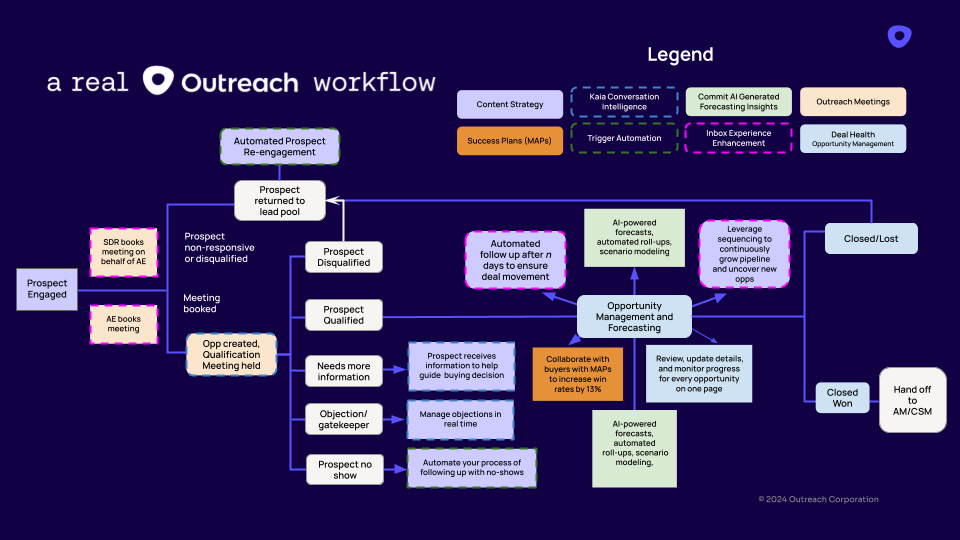Sales has a rigor problem. And we’re not afraid to say it.
For decades, Operations, IT, Finance, Supply Chain Management, and HR teams have been expected to execute their jobs in a disciplined, consistent, and process-driven manner. But revenue-generating teams have not been held to the same standard, because the process didn’t matter as long as enough people hit quota.
Revenue teams were able to ride the wave of boom sales times, but things are different in 2024. Sales cycles are more complex, every purchase is scrutinized, and there’s a renewed focus on profitability. Windfall masked shortcomings, and now the teams that lack revenue generation discipline are underperforming.
Past solutions have been two fold: raise quotas & hire rockstar leaders.
But this won’t cut it now. After a tough 2023, raising quotas will drive reps out. Rockstar leaders are harder to find, and you won’t be able to hire your way out of this – because this is a process problem, rather than a personnel problem. If the right structures aren’t in place, it doesn’t matter who gets hired, history will repeat itself.
Adaptation isn’t a choice, it’s a necessity. Twenty twenty-four demands a return to basics, and that includes better processes to measure execution and detect improvements. You shouldn't just be focused on the final signature, you should focus on everything that comes before it.
By dissecting sales workflows, identifying inefficiencies, and leveraging technology, sales teams can optimize their operations and drive sustainable growth.
Growth-at-any-cost left the market with a lingering hangover
New logo has always been flashy and alluring. But when buying cycles are longer and decision-making circles have gotten bigger, Customer Acquisition Costs (CAC) have skyrocketed, increasing the appeal of signatures you already have: existing customers. New logo is too expensive, and the odds of selling to an existing customer are much higher.
It’s not just statistically viable, it’s logical. Existing customers already trust your product, have a relationship, and (hopefully) are experiencing the benefits. Outreach’s Ali Jawin and Angela Garinger have already called it: 2024 will be the year to celebrate every dollar. By investing in customer success initiatives and identifying new use cases, companies can drive adoption and expand revenue streams – but executing it may not be that simple.
Sellers are facing a No-Decision Epidemic
CAC and growth amongst existing customers doesn’t come free. And one of the biggest, most detrimental factors driving up growth and acquisition costs is … nothing. More specifically, we’re referring to the decision gridlock.
Decision makers aren’t saying “no,” or “let’s circle back next quarter,” or “if we could just get it at a lower cost, we’re in,” they’re left saying nothing and time kills the deal. New deals and growth opportunities get caught in the bureaucratic lull, and this delay drives up the cost.
We have two hypotheses to explain this phenomenon – one you can’t control and one you can.
- The market for mid and small size tech companies hasn't turned around yet. Most large companies are buying from other large software players because it is safe, so smaller companies (Outreach included) are having a harder time getting customers to a decision. No one gets in trouble for choosing Microsoft or Salesforce because they are big, safe, identifiable brands who have built a loyal audience. We think this is also why we’re seeing the Nasdaq go up, but only the FAANG or the newer MATANA are the only ones gaining. All wildly out of your control… so feel free to take this one to your boards! That’s an Outreach freebie.
- Closing has gotten significantly harder. With more stakeholders, more people can say no and fewer can say yes. Even if you are the selected vendor of choice, there is still risk of indecision. But that doesn’t let you off the hook. In this environment, you need to move a deal forward in micro-commitments, building on each other and gaining momentum towards a close.
The best framework for micro commitments I have found is Anthony Iannarino’s 10 Commitments to close:
But even micro-commitments take deliberate strategy. The question then becomes, how do I know the reps are having the right conversations? How can we create a process to ensure my reps are getting all the commitments? Can we catch deals that are not moving forward early in the cycle so that we can disqualify them and focus on those that will? And we are all out of silver bullets: raising quota will only drive your talent away and all the rockstar revenue leaders have been pulled into and directed away from new opportunities.
Leaders should be looking to the team they already have, and creating the right processes to help them succeed in the long run. It’s cost-effective, morale-effective, and faster than traditional onboarding.
Workflows are the key
Hiring won’t save you, and neither will your CRM. This is an issue of process, and process gaps do not show up CRM. CRM only records the outcomes of the process, not if the process is being followed or successful. These processes happen in rep activities and customer conversations, so unless you have visibility into both, you won’t see what’s happening. Enter, workflows.
Any sales rep is familiar with the traditional workflow: a prospect is engaged, you book a meeting and determine if they’re qualified or not to move on to the next phase. But in 2024, we need visibility across the buyer journey.
The market is shifting from silver-bullet-centric to process-centric. Reliance on individual heroics is no longer sustainable. A process-centric approach, emphasizes visibility, measurability, and continuous improvement. By dissecting workflows, identifying inefficiencies, and leveraging technology, sales teams can optimize their operations and drive sustainable growth.
When data is siloed and you can’t tell what a prospect was told in the first call vs the fifth, you can’t determine the next best step to move the deal forward:
- No cross team info exchange
- No coaching opportunities
- No playbook for following up with a closed lost/disqualified lead
At Outreach, we started from the beginning. We traced our deals from the very first point of contact with a customer to the very end. This gave us the hard data we then used to evaluate which steps along the journey worked and which didn’t: Which reps were most successful and why? What was the consistent factor in closed lost deals? All of these insights were key to building out successful workflows that help our team win. This is the real life workflow we actually use:
Once you have visibility into each step and observability to your unique sales processes, then you can identify the areas of improvement, the areas of efficiency, what you need to stop doing or you need to do more of. Only then can you get real value out of supporting tools, softwares, and AI — generative or predictive — to drive more activity and better results and efficiencies.
What about AI?
There is a lot of AI Noise in the market, and Outreach happens to be part of it. Everyone is promoting AI tech but their value isn’t automatic for revenue teams.
In the past, AI had mostly meant pattern recognition and had been used to predict outcomes. Predictive AI has been successfully incorporated into most applications and has become table stakes for modern sales tools, but the insights it provides are not particularly actionable.
Generative AI like GPT exploded onto the market with high expectations. This technology can generate emails and summarize meetings – and that saves a ton of time.
But it doesn’t elevate sellers or highlight a clear path of action for REVENUE teams after that email has been created or that call summarized. It's a great general administrative AI tool, but it doesn’t indicate specific sales recommendations, specific to the sales process… and more importantly where you are in the customer’s journey from your customer’s point of view.
To incorporate the right AI into your processes, you need a thorough understanding of your workflows. That’s where AI will elevate and unlock your team’s full human potential and the power of your workflows.
In the future, sales-specific AI will do a number of pieces in the sales process to free the seller and manager to do quintessentially human things like coaching, working the deal, having meaningful conversations, progressing the deal, and deepening commitment. Automation will free up the administrative headache so sales people can do what they do best: sell.
How AI can improve sales workflows
- Predictive AI understands what could happen next and provides the next best actions to reduce the probability of a bad outcome (like an objection or a no show) and improve the probability of a good one, like next steps.
- Generative AI allows us to enhance the human to human communications and to do the mundane and manual work for the seller - like giving live guidance during calls and meetings, summarizing calls and auto generating post call coaching, and following-up with prospects or customers.
The more complex the situation, the more AI can help sellers to drive workflows. Now, sellers are free to focus on the core job of selling, of being change agents, and really being trusted advisors and buyers’ agents to their customers. Free or generic AI solutions in a GPT wrapper will likely not be the answer, you’ll need an AI partner that is specific to your processes. Obviously, we recommend Outreach, but as you explore your workflows and the AI landscape, the right AI solution is what will make the difference.
Workflow isn’t just another fancy buzzword you should adopt because it is trendy, they are the path forward for revenue organizations to be profitable. Workflows are the baseline for your 1-year, 3-year, 5-year sales strategies and the earlier you establish them the better.
Outreach helps build, optimize, and execute sales workflows
Outreach gives sales leaders a complete picture of the entire sales cycle so they can increase deal velocity, pipeline conversion, and rep productivity. The Outreach sales execution platform provides insight across the sales cycle into each step of a revenue workflow.
Sellers don’t just have all of the capabilities and insights they need to build pipeline, run meetings, navigate buying committees, and manage deals to close, but they’re also able to identify and anticipate deal disruptions, predict with 80-99% accuracy, and even recommend next steps – and that’s just scratching the surface.
Maximize your workflows (and everything else).
What got us here won’t get us there
The 2024 revenue market demands a new approach to growth, and it won’t just be about what you do, but how you do it, and how you measure it. A stronger process orientation to sales will give you the tools to have the right conversations and diagnose the areas of your customer journey.
For more on Manny’s insights on the evolution of workflows, follow him on LinkedIn . For more sales and workflow tips, follow Outreach.
Stay up-to-date with all things Outreach
Get the latest product news, industry insights, and valuable resources in your inbox.







